Operations on Large Numbers Class 5 Worksheet Maths
Question 1: Add the following numbers:
- 6,230 and 1,736 = 6230 + 1736 = 7966
- 2,536, 5,384 and 1,207 = 2536 + 5384 + 1207 = 9127
Question 2: Multiply the following numbers:
- 903 by 47 = 42441
- 6,354 by 208 = 1321632
- 4,005 by 192 = 768960
Question 3: Fill in the blanks:
- 0 + 9,573 = 9,573
- 612 × 8 = 8 × 612
- 8,305 × 10 = 83050
- 8,734 × 0 = 0
- 8,572 1,000 gives quotient = 8 and remainder = 572.
Question 4: Find the sum:

= 79322142
= 92943490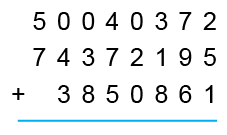
= 128263428
= 3761150
Question 5: Arrange in columns and add:
- 10,93,412; 53,09,426 and 4,01,58,394
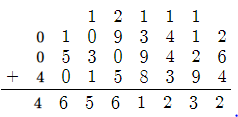
- 54,39,724; 4,32,01,582 and 3,91,264
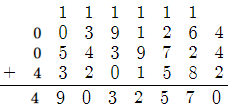
- 6,21,94,351; 37,25,001; 30,05,109 and 1,50,602
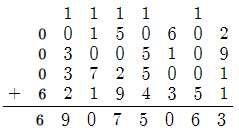
Question 6: Replace * by the correct digits:
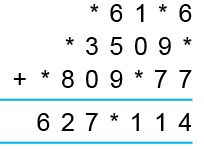
= 26156, 435090, 5809877
= 46376196, 35424627, 2801902
Question 7: A poultry farm produced 18,52,640; 19,25,439 and 20,05,419 eggs in three consecutive Years. Find the total number of eggs produced in the farm?
A poultry farm produced in 1 year = 18,52,640
A poultry farm produced in 2nd year = 19,25,439
A poultry farm produced 3rd year = 20,05,419
The total number of eggs produced in the farm = 18,52,640 + 19,25,439 + 20,05,419
= 5783498
Question 8: The number of tourists who visited Nainital in three successive years were 4,32,694; 53,90,861 and 6,35,418. How man tourists in all visited Nainital in those three years?
The number of tourists who visited Nainital in ist year = 4,32,694
The number of tourists who visited Nainital in 2nd years = 53,90,861
The number of tourists who visited Nainital in 3rd year = 6,35,418
The total no. of tourists visited Nainital in those three years = 4,32,694+53,90,861+ 6,35,418 = 6458973
Question 9: The population of a city is 25,00,054. Out of these, 13,85,768 are males. How man females are there in the city?
Total population of city = 25,00,054
No. of males = 13,85,768
No. of females = 25,00,054 - 13,85,768 = 1114286
Question 10: What must be added to 35,19,472 to get 5,13,72,510?
5,13,72,510 - 35,19,472 = 47853038
47853038 Must be added to 35,19,472 to get 5,13,72,510
Question 11: Using the properties of multiplication, fill in the blanks:
- 65,39,124 × 0 = 0.
- 0 × 8,32,196 = 0
- 7,325 × 5703 = 5,703 × 7,325
- 92,146 × 63,146 = 63,146 × 92146.
Question 12: A farmer produced 397 quintals of rice. He sold it at the rate of `1425 per quintal. How much mone did he get?
Total rice = 397 quintals
Rs. of 1 quintal = Rs. 1425
Total money = 397 x 1425 = 565725
Question 13: The weight of a bag containing wheat is 4 kg 750 g. What is the weight of 1,427 such bags? [1 kg = 1,000 g.]
Weight of 1 bag containing wheat = 4kg 750g = 4.750kg
So, weight of 1427 such bags = 4.75 × 1427
= 6778.25kg
Question 14: Fill in the blanks :
- 35,294 ÷ 1 = 35,294.
- 80,396 ÷ 80,396 = 1.
- 0 ÷ 1,42,603 = 0.
Question 15: Find the dividend:
- quotient = 271, remainder = 837, divisor = 1,000 = 271837
- quotient = 6,001, remainder = 59, divisor = 1,000 = 600159
- quotient = 6,934, remainder = 2, divisor = 10 = 69342
- quotient = 36,297, remainder = 12, divisor = 1,000 = 3629712
Question 16: If the dividend is 13,16,352 and the quotient is 256, what is the divisor?
Dividend = 1316352 and Quotient= 256
We know, Divisor = Dividend/ Quotient
Hence,
Divisor = 1316352/256
=5142
Question 17: Simplify:
- 40 – 25 ÷ 5 × 4 + 10
= 40 - {5 × 4} + 10 = 40 - 20 + 10
= 30 - 14 ÷ 7 + 2 – 1 × 3
= 2 + 2 - 3
= 4 - 3 = 1 - 60 – 90 ÷ 10 + 3 × 5
= 60 – 9 + 15 = 66
Question 18: What is the difference of the largest 6-digit number and the smallest 7-digit number?
The largest 6-digit number is 999,999, as it consists of six 9s.
The smallest 7-digit number is 1,000,000, as it consists of six 0s followed by a 1.
Now, let's calculate the difference:
999,999 (largest 6-digit number)
1,000,000 (smallest 7-digit number)
= 1000000 - 999999 = 1
So, the difference between the largest 6-digit number and the smallest 7-digit number is 1.
Question 19: 2,86,938 ÷ 1,000 gives quotient = ______ and remainder = ______.
2,86,938 ÷ 1,000 gives quotient = 286 and remainder = 938
Question 20: What number should be subtracted from 61,579 so that the remainder is divisible by 100?
79 should be subtracted from 61579 to get divisible by 100.
61579 - 79 = 61500 which is divisible by 100
61500/100 = 615
|
56 videos|187 docs|40 tests
|
FAQs on Operations on Large Numbers Class 5 Worksheet Maths
| 1. What are some examples of operations on large numbers? |  |
| 2. How do you add large numbers? |  |
| 3. What is the process for subtracting large numbers? |  |
| 4. How do you multiply large numbers? |  |
| 5. What is the process for dividing large numbers? |  |

















